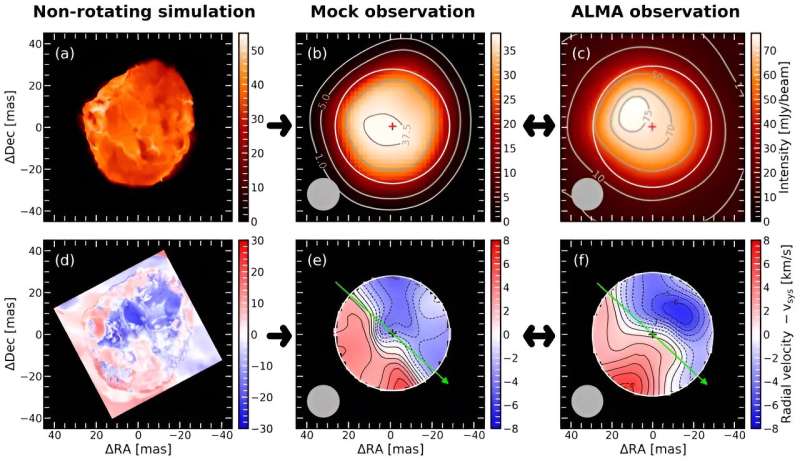This article has been reviewed according to Science X's editorial process and policies. Editors have highlighted the following attributes while ensuring the content's credibility:
fact-checked
trusted source
proofread
A new spin on Betelgeuse's boiling surface

Betelgeuse is a well-known red supergiant star in the constellation Orion. Recently it has gained a lot of attention, not only because variations in its brightness led to speculations that an explosion might be imminent, but also because observations indicated that it's rotating much faster than expected.
This latter interpretation is now put into question by an international team led by astronomers at Max Planck Institute for Astrophysics, who propose that Betelgeuse's boiling surface can be mistaken for rotation even in the most advanced telescopes. Other astronomers are actively analyzing new observational data to test such hypotheses.
As one of the brightest stars in the northern hemisphere, Betelgeuse can be easily found by the naked eye in the constellation of Orion. Betelgeuse is one of the biggest stars known. With a diameter larger than 1 billion kilometers, it is almost 1,000 times larger than the sun. If it had been in our solar system, it would have engulfed Earth with its atmosphere reaching Jupiter.
A star that large is not supposed to rotate fast. In their evolution, most stars expand and spin down to conserve angular momentum. However, recent observations suggested that Betelgeuse is rotating quite fast (at 5 km/s), two orders of magnitude faster than a single evolved star should spin.
The most prominent evidence for Betelgeuse's rotation came from the Atacama Large Millimeter/submillimeter Array (ALMA). The 66 antennas at ALMA work together as though they were a single giant telescope. They use a technique known as interferometry, where two or more antennas pick up a signal from the universe and join forces to analyze the signal and obtain information on its source of emission.
Using this technique, astronomers discovered a dipolar radial velocity map on the outer layer of Betelgeuse: Half of the star appears to be approaching us, and the other half seems to be receding. This observation, along with previous studies, led to the interpretation that Betelgeuse is rapidly rotating.
This interpretation would have been a clear case, if Betelgeuse was a perfectly round sphere. However, the surface of Betelgeuse is a vibrant world, governed by a physical process called convection. We can observe convection in our daily life when we boil water, but in Betelgeuse, this process is much more violent: The boiling bubbles can be as large as Earth's orbit around the sun, covering a large fraction of Betelgeuse's surface. They rise and fall at a speed of up to 30 km/s, faster than any crewed spacecraft.
Based on this physical picture, an international team led by Jing-Ze Ma, Ph.D. student at the Max Planck Institute for Astrophysics now offers an alternative explanation to Betelgeuse's dipolar velocity map: Betelgeuse's boiling surface mimics rotation. A cluster of boiling bubbles rise on one side of the star, and another group of bubbles sink on the other side. Due to the limited resolution of the ALMA telescope, such convective motions would be blurred in actual observations, which would result in the dipolar velocity map.
The work is published in The Astrophysical Journal Letters.
The team developed a new post-processing package to produce synthetic ALMA images and submillimeter spectra from their 3D radiation hydrodynamic simulations of nonrotating red supergiant stars. In 90% of the simulations, the star would be interpreted as rotating at several km/s simply because of the large-scale boiling motions on the surface that are not clearly seen in the ALMA telescope.
Further observations are needed to better assess the rapid rotation of Betelgeuse, and the team made predictions for future observations with higher spatial resolution. Fortunately, other astronomers have already made higher-resolution observations of Betelgeuse in 2022. The new data is being analyzed right now, which will put the predictions to the test and help unveil the mask of Betelgeuse.
"Most stars are just tiny points of light in the night sky. Betelgeuse is so incredibly large and nearby that, with the very best telescopes, it is one of the very few stars where we actually observe and study its boiling surface. It still feels a bit like a science fiction movie, as if we have traveled there to see it up close," says co-author Selma de Mink (director at the Max Planck Institute for astrophysics). "And the results are so exciting. If Betelgeuse is rapidly rotating after all, then we think it must have been spun up after eating a small companion star that was orbiting it."
"There is so much we still don't understand about gigantic boiling stars like Betelgeuse," says co-author Andrea Chiavassa, astronomer at CNRS. "How do they really work? How do they lose mass? What molecules can form in their outflows? Why did Betelgeuse suddenly get less bright? We are working very hard to make our computer simulations better and better, but we really need the incredible data from telescopes like ALMA."
More information: Jing-Ze 竟泽 Ma 马 et al, Is Betelgeuse Really Rotating? Synthetic ALMA Observations of Large-scale Convection in 3D Simulations of Red Supergiants, The Astrophysical Journal Letters (2024). DOI: 10.3847/2041-8213/ad24fd
Provided by Max Planck Society




















